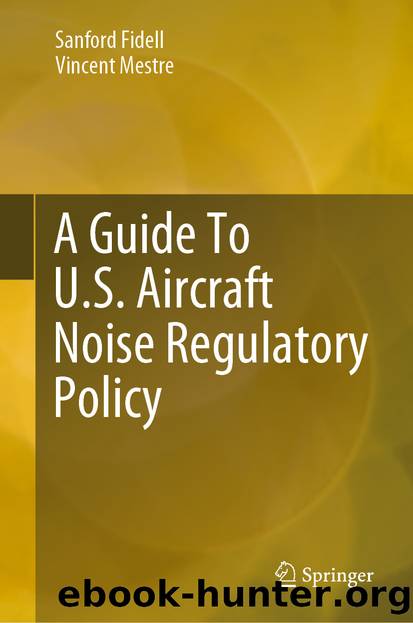A Guide To U.S. Aircraft Noise Regulatory Policy by Sanford Fidell & Vincent Mestre

Author:Sanford Fidell & Vincent Mestre
Language: eng
Format: epub
ISBN: 9783030399085
Publisher: Springer International Publishing
This statement of accuracy made by the FAA in 1983 has not been updated in such an explicit form since 1983. No doubt modeling methods and database improvements have reduced the uncertainty, but there has been no similarly explicit statement published. In 2017, FAA published a comprehensive guide to the uncertainty of the AEDT model that exhaustively looks at each variable and its effect on uncertainty (FAA 2017). The 2017 report makes no attempt to work out an overall measure of uncertainty in units of DNL, as such an overall estimate of uncertainty requires knowledge of the uncertainty of each individual variable, and of methods that may vary from case to case.
A similar examination of modeling uncertainty undertaken in Europe (Eurocontrol 2002) addressed the uncertainty of individual variables and methods, but made no attempt to combine these individual uncertainties into an overall DNL uncertainty. Although it is not possible to generalize an estimate of uncertainty for modeled DNL in all cases, uncertainty limits can be evaluated in specific cases. Anecdotally, most modelers consider that ±1.5 dB of uncertainty is achievable in the vicinity of the Ldn = 65 dB when good operations and flight track data are available for a sea-level airport lacking extraordinary terrain or meteorological anomalies. Uncertainty would increase at lower DNL values. This assessment is based on casual comparisons of noise model results at airports with permanent noise monitoring systems. A large survey of such airports and their noise modeling would be of great value.
Contour Mapping
The density of the analysis grid determines the resolution of the contours. A coarse grid, with large grid point spacing, will produce a rougher edged contour than a finer grid with less distance between grid points. In fact, the contouring software packages contain parameter settings that will draw slightly different contours from the same grid points. The implication of the mapping interpolation is an added uncertainty of model estimates (discussed earlier) that needs to be understood as part of policy development.
Overall public understanding of aircraft noise exposure contours is often poor. The public frequently misunderstands the unit of long-term cumulative noise exposure (DNL) that is most often contoured, and misinterprets the “annual average day” condition modeled as a noise condition that can actually be heard. Some airports have pronounced seasonal shifts in operating patterns. Vacation destinations, for example, often have strong summer or winter seasonal peaks in flight schedules. Modeling noise exposure at such airports on an average annual day basis risks misrepresenting the aircraft noise that drives actual community response.
Comparing community noise complaint patterns to long-term noise exposure contours is thus problematic. A complaint, while possibly influenced by long-term exposure, is often linked to one or more specific noise events. These can include anomalous flight operations that are so infrequent as to exert negligible influence on annual average noise exposure contours. Community attitude surveys, on the other hand, are designed to quantify long-term, community-wide attitudes about aircraft noise. Community attitude surveys, rather than complainant locations, are used to construct relationships between long-term noise exposure and community response.
Download
This site does not store any files on its server. We only index and link to content provided by other sites. Please contact the content providers to delete copyright contents if any and email us, we'll remove relevant links or contents immediately.
| Automotive | Engineering |
| Transportation |
Whiskies Galore by Ian Buxton(41530)
Introduction to Aircraft Design (Cambridge Aerospace Series) by John P. Fielding(32888)
Small Unmanned Fixed-wing Aircraft Design by Andrew J. Keane Andras Sobester James P. Scanlan & András Sóbester & James P. Scanlan(32573)
Craft Beer for the Homebrewer by Michael Agnew(17933)
Turbulence by E. J. Noyes(7700)
The Complete Stick Figure Physics Tutorials by Allen Sarah(7138)
Kaplan MCAT General Chemistry Review by Kaplan(6595)
The Thirst by Nesbo Jo(6436)
Bad Blood by John Carreyrou(6274)
Modelling of Convective Heat and Mass Transfer in Rotating Flows by Igor V. Shevchuk(6223)
Learning SQL by Alan Beaulieu(6035)
Weapons of Math Destruction by Cathy O'Neil(5829)
Man-made Catastrophes and Risk Information Concealment by Dmitry Chernov & Didier Sornette(5647)
Digital Minimalism by Cal Newport;(5389)
Life 3.0: Being Human in the Age of Artificial Intelligence by Tegmark Max(5184)
iGen by Jean M. Twenge(5161)
Secrets of Antigravity Propulsion: Tesla, UFOs, and Classified Aerospace Technology by Ph.D. Paul A. Laviolette(4991)
Design of Trajectory Optimization Approach for Space Maneuver Vehicle Skip Entry Problems by Runqi Chai & Al Savvaris & Antonios Tsourdos & Senchun Chai(4840)
Electronic Devices & Circuits by Jacob Millman & Christos C. Halkias(4748)
